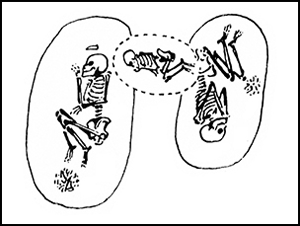Crossref Citations
This article has been cited by the following publications. This list is generated based on data provided by
Crossref.
Brück, Joanna
2021.
Kinship: politics and practice.
Antiquity,
Vol. 95,
Issue. 379,
p.
249.
Crellin, Rachel J.
2021.
Making posthumanist kin in the past.
Antiquity,
Vol. 95,
Issue. 379,
p.
238.
Žegarac, A.
Winkelbach, L.
Blöcher, J.
Diekmann, Y.
Krečković Gavrilović, M.
Porčić, M.
Stojković, B.
Milašinović, L.
Schreiber, M.
Wegmann, D.
Veeramah, K. R.
Stefanović, S.
and
Burger, J.
2021.
Ancient genomes provide insights into family structure and the heredity of social status in the early Bronze Age of southeastern Europe.
Scientific Reports,
Vol. 11,
Issue. 1,
Furholt, Martin
2021.
Exploring human possibilities.
Antiquity,
Vol. 95,
Issue. 379,
p.
244.
Soriano, I.
Herrero-Corral, A.M.
Garrido-Pena, R.
and
Majó, T.
2021.
Sex/gender system and social hierarchization in Bell Beaker burials from Iberia.
Journal of Anthropological Archaeology,
Vol. 64,
Issue. ,
p.
101335.
Frieman, Catherine J.
2021.
Emergent or imposed?.
Antiquity,
Vol. 95,
Issue. 379,
p.
247.
Ensor, Bradley E.
2021.
Making aDNA useful for kinship analysis.
Antiquity,
Vol. 95,
Issue. 379,
p.
241.
Cintas-Peña, Marta
and
García Sanjuán, Leonardo
2022.
Women, residential patterns and early social complexity. From theory to practice in Copper Age Iberia.
Journal of Anthropological Archaeology,
Vol. 67,
Issue. ,
p.
101422.
Moore, Hazel
Wilson, Graeme
Ni Challanain, Mairead
McCormick, Maeve
Marshall, Peter D.
Dulias, Katharina
Foody, M. George B.
Justeau, Pierre
Pala, Maria
Richards, Martin B.
and
Edwards, Ceiridwen J.
2022.
Migration and community in Bronze Age Orkney: innovation and continuity at the Links of Noltland.
Antiquity,
Vol. 96,
Issue. 387,
p.
541.
Laing, Meredith
2022.
YOUNG HANDS AT WORK. USING FINGER IMPRESSIONS TO EXPLORE THE DEMOGRAPHIC CONSTITUTION OF EARLY AND MIDDLE BRONZE AGE POTTERY‐MAKING COMMUNITIES OF PRACTICE.
Oxford Journal of Archaeology,
Vol. 41,
Issue. 4,
p.
350.
Brück, Joanna
and
Booth, Thomas J.
2022.
The Power of Relics: The Curation of Human Bone in British Bronze Age Burials.
European Journal of Archaeology,
Vol. 25,
Issue. 4,
p.
440.
Fowler, Chris
Olalde, Iñigo
Cummings, Vicki
Armit, Ian
Büster, Lindsey
Cuthbert, Sarah
Rohland, Nadin
Cheronet, Olivia
Pinhasi, Ron
and
Reich, David
2022.
A high-resolution picture of kinship practices in an Early Neolithic tomb.
Nature,
Vol. 601,
Issue. 7894,
p.
584.
Carlin, Neil
2022.
A grave matter of ancient kinship in Neolithic Britain.
Nature,
Vol. 601,
Issue. 7894,
p.
510.
Fowler, Chris
2022.
Social arrangements. Kinship, descent and affinity in the mortuary architecture of Early Neolithic Britain and Ireland.
Archaeological Dialogues,
Vol. 29,
Issue. 1,
p.
67.
Bentley, R. Alexander
2022.
Prehistory of Kinship.
Annual Review of Anthropology,
Vol. 51,
Issue. 1,
p.
137.
BLOXAM, ANNA
and
PARKER PEARSON, MIKE
2022.
Funerary Diversity and Cultural Continuity: The British Beaker Phenomenon Beyond the Stereotype.
Proceedings of the Prehistoric Society,
Vol. 88,
Issue. ,
p.
261.
ABEL, SARAH
and
FRIEMAN, CATHERINE J.
2023.
On gene-ealogy: identity, descent, and affiliation in the era of home DNA testing.
Anthropological Science,
Vol. 131,
Issue. 1,
p.
15.
Skourtanioti, Eirini
Ringbauer, Harald
Gnecchi Ruscone, Guido Alberto
Bianco, Raffaela Angelina
Burri, Marta
Freund, Cäcilia
Furtwängler, Anja
Gomes Martins, Nuno Filipe
Knolle, Florian
Neumann, Gunnar U.
Tiliakou, Anthi
Agelarakis, Anagnostis
Andreadaki-Vlazaki, Maria
Betancourt, Philip
Hallager, Birgitta P.
Jones, Olivia A.
Kakavogianni, Olga
Kanta, Athanasia
Karkanas, Panagiotis
Kataki, Efthymia
Kissas, Konstantinos
Koehl, Robert
Kvapil, Lynne
Maran, Joseph
McGeorge, Photini J. P.
Papadimitriou, Alkestis
Papathanasiou, Anastasia
Papazoglou-Manioudaki, Lena
Paschalidis, Kostas
Polychronakou-Sgouritsa, Naya
Preve, Sofia
Prevedorou, Eleni-Anna
Price, Gypsy
Protopapadaki, Eftychia
Schmidt-Schultz, Tyede
Schultz, Michael
Shelton, Kim
Wiener, Malcolm H.
Krause, Johannes
Jeong, Choongwon
and
Stockhammer, Philipp W.
2023.
Ancient DNA reveals admixture history and endogamy in the prehistoric Aegean.
Nature Ecology & Evolution,
Vol. 7,
Issue. 2,
p.
290.
Knight, Matthew G.
2023.
Nostalgia in the prehistoric archaeological record.
Current Opinion in Psychology,
Vol. 50,
Issue. ,
p.
101560.
Frieman, Catherine J.
2023.
Archaeology as History.
